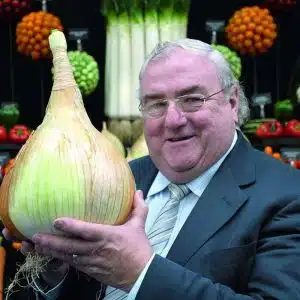Home - Sowing and Growing Parsnips

Medwyn Williams
Hello. I'm Medwyn Williams – eleven times Gold medal winner at the Chelsea Flower Show, Past Chairman of the Royal Horticultural Society Fruit Vegetable and Herb Committee and President of the National Vegetable Society.
Sowing and Growing Parsnips
Different growing mixtures, cultivars and timing makes the difference between show winning parsnips and the also ran.
Sowing Parsnips
It’s time to be thinking about sowing your Parsnip seed again; it never ceases to amaze me how fast the seasons turn around, it seems to be happening at a faster rate than ever now that I”ve turned sixty! To be honest I’ve been going backwards a bit on parsnips and last year was the worst batch that I have ever grown, simply because of dabbling with different mixtures. Over the years I have used many different composts, some with soil added others with nothing more than peat and sand, and to some degree they all work reasonably well.
Growing Medium for Parsnips & Varieties
With parsnips though I do firmly believe that some soil in the mixture is essential in order to maintain optimum growth right through the season. There’s no doubt that both the size and quality of parsnips have improved no end over the past decade or so. The improvement that we have seen is not down to simply one thing that you can put your finger on either, it seems to have evolved over this period. I suppose the breeding and introduction of the first F1 hybrid parsnip called Gladiator by Dr Peter Dawson started the chain of events moving forward.
Prior to the introduction of Gladiator we only had what we know as the straight or self pollinating varieties such as Tender and True, Lisbonais, Hollow Crown Improved and The Student. These of course were excellent in their day but nowhere near on par with the newer hybrids. Gladiator was soon followed by Javelin, then Archer and Dagger, all bred by Dr Dawson. Other hybrids have quickly followed over the past few years from different breeders so we now have Paragon, Panache, and last year from a third breeder we had Countess.
Even though all of those above are good, and Countess, on it’s debut last year made a big impact on the show benches, Gladiator still seems to be the one to beat. The big attribute that Gladiator has is it’s ability to grow very large with a big heavy shoulders whilst at the same time retaining superb quality skin finish. The set of three Gladiator first shown by Jack Arrowsmith at the Welsh Championships in Brecon a few years ago are still being talked about as are the five that won him the National Vegetable Society class at Malvern Last Year.
Another excellent grower of Parsnips and long carrots is Gerald Treweek who always turns out top quality specimens on a regular basis. Gerald’s banker parsnips are Gladiator and Dagger, the latter having excellent from and a lovely skin finish. This year I intend to have ago at Gerald’s mixture which is as follows : 16 litres of Sieved Moss Peat, 16 litres of Silver Sand and 16 litres of sieved loam, all the above, even the silver sand is sieved through an eighth of an inch sieve. This is accomplished by Gerald through a power sieve that he has designed himself, he even sieves the Silver sand as occasionally you can have the odd large piece of shell in it.
Loam in the Growing Mixture
The soil or loam that Gerald uses is a commercial product called Mendip loam, however I intend to stick with the bagged Top Soil from Westland Horticulture. I used this for the first time last season and I was truly amazed at the high quality of it. As soon as I opened the bags I knew I had the real Macoy in my hand because it had some fine root hairs in it and smelt like good quality loam should smell. It is a specially selected and graded Irish top soil that has also been sterilised and comes in convenient to handle 25 litre bags. To the above 48 litres of compost add 7 ounces of Chempak Potting Base and 4 ounces of Carbonated Lime (Garden Lime)
My beds, under last years new cover, were all emptied out and refilled during late October last year and a sprinkler was than left on it to thoroughly soak the sand and wash out any salts that may have built up. When the beds were filled back they were well heaped up forming a ridge along the middle, after the soaking, the whole bed had settled down to such an extent that I had to import approximately two inches of sand on top of each one.
For some years now I have been coring out my bore holes using a four inch pipe, initially to go down 30 inches, this is followed by a 3 inch pipe which goes down to over 4 feet. (picture attached) The cored hole is then shaped to it’s final size by using a steel pointed bar which will give me a depth of around 5ft 6 inches and a diameter at the top of 5 inches. When shaped properly, it is a big hole, and certainly takes a large amount of compost to fill each one. After filling the compost approximately half way, I use a piece of wood to prod it down just to make sure that there are no air locks or voids in it. When it’s been filled right up to the top a small indentation about half an inch deep will be made in the centre of each hole with my finger and four seed placed on edge in each station and covered over with the same compost and watered well.
I intend to sow 20 Gladiator on one side and 20 Dagger on other, if you have no cover and they are being sown directly outside, make sure the drums or beds are covered over with panes of glass until the seed have germinated.
